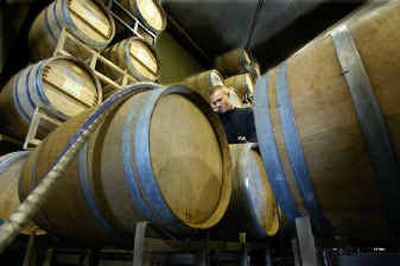Hard freeze may bring better vintage at state’s wineries

A hard freeze last winter bit into the state’s rapidly growing wine industry.
Yet the same temperatures that cut harvest numbers may contribute to a superb vintage, winemakers say.
“There are not a whole lot of extra grapes out there, but from a quality standpoint, we could see intense flavors,” said Arbor Crest winemaker Jim Van Loben Sels. “(The year) 2004 may be special.”
The wine-grape harvest this year is expected to total about 105,000 tons, a number that falls short of last year’s 112,000 tons, even as more vineyards were poised to produce more fruit, according to the Washington Agricultural Statistics Service.
The state’s largest-ever wine grape bounty was in 2002, when 115,000 tons were harvested.
There had been fears that smaller, boutique wineries might not be able to get grapes to crush this autumn, leaving them without a 2004 vintage to offer.
That likely won’t happen, though, said Stacie Jacob of the Washington Wine Commission.
While vineyards in the Walla Walla region shouldered the brunt of a nasty cold spell that settled in lower elevations, vine damage in the state’s other major grape-growing regions, the Columbia Valley and the Yakima Valley, wasn’t as severe.
The freeze may slow the dramatic rise of the Washington wine, but any setback will be temporary.
Consider this: The state’s wine industry has doubled since 1996, the last time a devastating freeze afflicted vineyards.
There are now about 300 wineries in the state – including nine in Spokane – using grapes grown across 30,000 acres.
Mike Conway, winemaker at Spokane’s Latah Creek Winery, said the worst damage last winter was done to Merlot vines, which are more susceptible to weather. Latah, which sells more light and fruity white wines, is expecting to get as many grapes as it needs.
“It’s the small wineries that depended on very limited areas that might be in trouble,” Conway said.
Wine drinkers likely won’t pay much more for the 2004 vintage. There’s still going to be plenty of wine and Washington wineries are mindful of keeping and growing market share in the face of competition not just from California, but also from places like Australia and Chile. But the real upside for consumers may be the quality.
Smaller berries have been reported across the state as vines struggled to rebound from the freeze, said Craig Leuthold of the Maryhill Winery near Goldendale.
Admiring clusters of newly picked Merlot grapes from a nearby vineyard, Leuthold commented that the grapes, about the size of a fat blueberry with thick skins and deep purple coloring, should make for a memorable vintage.
In Spokane, Van Loben Sels said the Eastern Washington freeze last January helped to naturally thin grape clusters.
One Arbor Crest vineyard that was especially hit hard was its notable Dionysus block 16.
“It was just nailed this year,” he said, adding that the winery won’t take fruit from that block this year in hopes of helping the vines rebound next year.
The winery, perched above the Spokane River, will produce about 18,000 to 20,000 cases this year, Van Loben Sels said.
Driving through Washington’s vineyard areas, motorists can see damaged vines and those that have been cut back.
“It’s one of those things the industry will go through,” Jacob said.
While the state is mostly known for its red wines, which normally outnumber whites 57 percent to 43 percent, the freeze may bring those numbers a bit closer. The leading varieties made in the state are chardonnay, merlot and cabernet sauvignon.